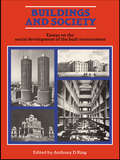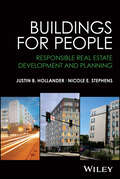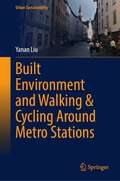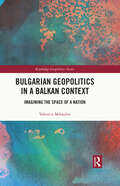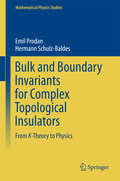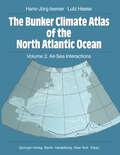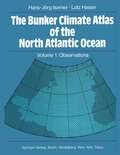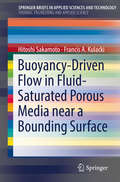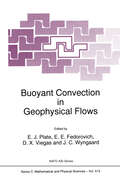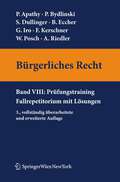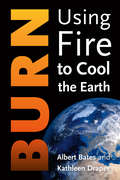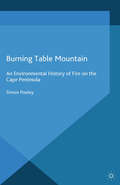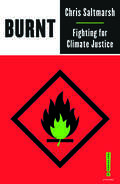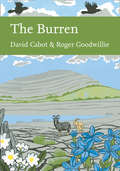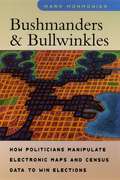- Table View
- List View
Buildings and Society: Essays on the Social Development of the Built Environment
by Anthony D. KingFirst Published in 1984. Routledge is an imprint of Taylor & Francis, an informa company.
Buildings for People: Responsible Real Estate Development and Planning
by Justin B. Hollander Nicole E. StephensBUILDINGS FOR PEOPLE Buildings for People: Responsible Real Estate Development and Planning explores how to balance social concerns with financial and investment considerations without sacrificing profit. This timely volume provides key technical and practical knowledge while exploring real estate development and planning through a multi-level lens—revealing the systemic factors that both govern and are governed by the real estate process. Beginning with site selection, the authors discuss financing, site improvement, architecture, landscape architecture, site planning, construction, and evaluation within a broader political, economic, and social context. Throughout the text, the authors explain key theories and methods of professional practice, and highlight how important social issues are interconnected to the business of real estate development and planning. Demonstrating how the desire for profit can be balanced with the needs of society Buildings for People: Responsible Real Estate Development and Planning is an excellent textbook for advanced undergraduate and graduate students in real estate, urban planning, urban design, and urban studies courses, as well as a valuable resource for researchers and professionals who want a multidisciplinary understanding of the built environment.
Buildings for People: Responsible Real Estate Development and Planning
by Justin B. Hollander Nicole E. StephensBUILDINGS FOR PEOPLE Buildings for People: Responsible Real Estate Development and Planning explores how to balance social concerns with financial and investment considerations without sacrificing profit. This timely volume provides key technical and practical knowledge while exploring real estate development and planning through a multi-level lens—revealing the systemic factors that both govern and are governed by the real estate process. Beginning with site selection, the authors discuss financing, site improvement, architecture, landscape architecture, site planning, construction, and evaluation within a broader political, economic, and social context. Throughout the text, the authors explain key theories and methods of professional practice, and highlight how important social issues are interconnected to the business of real estate development and planning. Demonstrating how the desire for profit can be balanced with the needs of society Buildings for People: Responsible Real Estate Development and Planning is an excellent textbook for advanced undergraduate and graduate students in real estate, urban planning, urban design, and urban studies courses, as well as a valuable resource for researchers and professionals who want a multidisciplinary understanding of the built environment.
Built Environment and Walking & Cycling Around Metro Stations (Urban Sustainability)
by Yanan LiuThis book explores the relationship between pedestrians/cyclists’ mode and route choice to/from metro/railway stations and the micro-level (street-scale) built environment in a second-tier city in China. More specifically, it investigates how the street-scale built environment influences pedestrians/cyclists’ mode choice and route choice behavior and examines user preferences for the micro-level built environment around metro stations. The focus on a second-tier city is motivated primarily to expand the set of Chinese cities where the effects of the built environment on pedestrian/cyclist mode and route choice have been studied. Results demonstrate the effects of the street-scale built environment on pedestrian flows. The effects are higher for the main road, which is directly connected with the metro station. The findings of this book are expected to support the design of preferred walking/biking built environments around a metro station. This book appeals to urbanists, planners, engineers, policy makers, and those interested in a wide-ranging overview of slow/green transportation and built environment promotion. These methods not only help to understand the quantitative relationship between built environment design and travel behavior but also support the evaluation and assessment of built environment design in urban planning projects. It reduces the gap in our understanding of the quantitative relationship between the micro-level built environment and pedestrians/cyclists’ transportation mode and route choice around the metro station. Both stated choice data and revealed choice data were used. An extended set of micro-level built environment attributes was developed. Besides the widely studied transportation-related factors, street-level built environment factors were studied using quantitative methods.
Bulgarian Geopolitics in a Balkan Context: Imagining the Space of a Nation (Routledge Geopolitics Series)
by Valentin MihaylovThis book is about the geographic space as an inseparable component of a nation’s historical memory, territorial awareness, geopolitical visions, and obsessions.The empirical part of the book focuses on the critical analysis of first-hand sources containing representations of the imagined spaces and places of Bulgaria and Bulgarians from a long-term perspective. The research results are structured in accordance with the author’s model of an imagined national space. It contains three general domains: possessed national space, the ethnogeopolitical neighbourhood, and ancient and legendary spaces. The book also explores how Bulgarians’ historical and ethnic spaces are linked with specific geopolitics, such as passive internal geopolitics, soft revisionism, non-intervening geopolitical claims, blocking international integration as a disguised form of old territorial claims, and emerging historical geopolitics. It examines how the imagined national space is approached by statesmen, politicians, academics, and other creators of ‘high’ geopolitics. The book also pays attention to the role of spatial imaginations in growing ‘low’ (popular) geopolitics, which includes media, popular culture, and national mythology.Written in an interdisciplinary manner, this timely book will attract the interest of scholars and students in geopolitics, human geography, international relations, nationalism studies, and ethnic history.
Bulgarian Geopolitics in a Balkan Context: Imagining the Space of a Nation (Routledge Geopolitics Series)
by Valentin MihaylovThis book is about the geographic space as an inseparable component of a nation’s historical memory, territorial awareness, geopolitical visions, and obsessions.The empirical part of the book focuses on the critical analysis of first-hand sources containing representations of the imagined spaces and places of Bulgaria and Bulgarians from a long-term perspective. The research results are structured in accordance with the author’s model of an imagined national space. It contains three general domains: possessed national space, the ethnogeopolitical neighbourhood, and ancient and legendary spaces. The book also explores how Bulgarians’ historical and ethnic spaces are linked with specific geopolitics, such as passive internal geopolitics, soft revisionism, non-intervening geopolitical claims, blocking international integration as a disguised form of old territorial claims, and emerging historical geopolitics. It examines how the imagined national space is approached by statesmen, politicians, academics, and other creators of ‘high’ geopolitics. The book also pays attention to the role of spatial imaginations in growing ‘low’ (popular) geopolitics, which includes media, popular culture, and national mythology.Written in an interdisciplinary manner, this timely book will attract the interest of scholars and students in geopolitics, human geography, international relations, nationalism studies, and ethnic history.
Bulk and Boundary Invariants for Complex Topological Insulators: From K-Theory to Physics (Mathematical Physics Studies)
by Emil Prodan Hermann Schulz-BaldesThis monograph offers an overview of rigorous results on fermionic topological insulators from the complex classes, namely, those without symmetries or with just a chiral symmetry. Particular focus is on the stability of the topological invariants in the presence of strong disorder, on the interplay between the bulk and boundary invariants and on their dependence on magnetic fields.The first part presents motivating examples and the conjectures put forward by the physics community, together with a brief review of the experimental achievements. The second part develops an operator algebraic approach for the study of disordered topological insulators. This leads naturally to the use of analytical tools from K-theory and non-commutative geometry, such as cyclic cohomology, quantized calculus with Fredholm modules and index pairings. New results include a generalized Streda formula and a proof of the delocalized nature of surface states in topological insulators with non-trivial invariants. The concluding chapter connects the invariants to measurable quantities and thus presents a refined physical characterization of the complex topological insulators. This book is intended for advanced students in mathematical physics and researchers alike.
The Bunker Climate Atlas of the North Atlantic Ocean: Air-Sea Interactions (Topics in Atmospheric and Oceanic Sciences)
by Hans-Jörg Isemer Lutz HasseMarine Meteorology has a long tradition, and studies of surface meteorological conditions have been published repeatedly since the end of the last century. Recently, the demand has grown for more detailed descriptions. This stems both from the public's interest in climatic change and from our growing ability to analyse atmospheric and oceanic processes with the aid of numerical models. These models require input data on a regular, finely spaced grid; the increased amount of oceanic data available permits us to provide detailed charts both of surface meteorological conditions and of air-sea interactions. The present atlas deals with the surface climate of the North Atlantic Ocean from the equator to 65°N, in the period 1941 to 1972. It is based on data originally evaluated by Andrew F. Bunker of Woods Hole Oceanographic Institution. He analysed observations from the ships of the Voluntary Observing Fleet in many parts of the world ocean to calculate the various components of the heat budget at the air-sea interface. When Bunker died in 1979, he left the major part of his data and results in an unpublished state. Since he had spent considerable effort on validating the data and calculating air-sea fluxes by the so-called individual method, it was considered worthwhile to make this unique set of climate data available to the scientific community. The observed meteorological quantities are presented in Volume 1 of this atlas. Volume 2 contains the air-sea interaction fluxes.
The Bunker Climate Atlas of the North Atlantic Ocean: Volume 1: Observations (Topics in Atmospheric and Oceanic Sciences)
by H.-J. Isemer L. HasseMarine Meteorology has a long tradition, and studies of surface meteorological conditions have been published repeatedly since the end of the last century. Recently, the demand has grown for more detailed descriptions. This stems both from the public's interest in climatic change and from our growing ability to analyse atmospher ic and oceanic processes with the aid of numerical models. These models require input data on a regular, finely spaced grid; the increased amount of oceanic data available permits us to provide detailed charts both of surface meteorological conditions and of the air-sea interaction. The present climate atlas of the North Atlantic Ocean is based on data originally evaluated by Andrew F. Bunker of Woods Hole Oceanographic Institution. He analysed observations from the ships of the Voluntary Observing Fleet in many parts of the world oceans to calculate the various components of the heat budget at the air sea interface. When Bunker died in 1979, he left the major part of his data and results in an unpublished state. Since he had expended considerable effort to validate the data and calculate air-sea fluxes by the so-called "individual method" , it was considered worthwhile to make this unique set of climate data available to the scientific community. Bunker's analysed fields for the North Atlantic Ocean are presented in this atlas. It deals with the surface climate of the North Atlantic Ocean from the equator to 65°N, in the period 1941 to 1972.
Buoyancy-Driven Flow in Fluid-Saturated Porous Media near a Bounding Surface (SpringerBriefs in Applied Sciences and Technology)
by Hitoshi Sakamoto Francis A. KulackiThis Brief reports on heat transfer from a solid boundary in a saturated porous medium. Experiments reveal overall heat transfer laws when the flow along the wall is driven by buoyancy produced by large temperature differences, and mathematical analysis using advanced volume-averaging techniques produce estimates of how heat is dispersed in the porous zone. Engineers, hydrologists and geophysicists will find the results valuable for validation of laboratory and field tests, as well as testing their models of dispersion of heat and mass in saturated media.
Buoyant Convection in Geophysical Flows (Nato Science Series C: #513)
by Erich J. Plate E. E. Fedorovich Domingos X. Viegas J. C. WyngaardStudies of convection in geophysical flows constitute an advanced and rapidly developing area of research that is relevant to problems of the natural environment. During the last decade, significant progress has been achieved in the field as a result of both experimental studies and numerical modelling. This led to the principal revision of the widely held view on buoyancy-driven turbulent flows comprising an organised mean component with superimposed chaotic turbulence. An intermediate type of motion, represented by coherent structures, has been found to play a key role in geophysical boundary layers and in larger scale atmospheric and hydrospheric circulations driven by buoyant forcing. New aspects of the interaction between convective motions and rotation have recently been discovered and investigated. Extensive experimental data have also been collected on the role of convection in cloud dynamics and microphysics. New theoretical concepts and approaches have been outlined regarding scaling and parameterization of physical processes in buoyancy-driven geophysical flows. The book summarizes interdisciplinary studies of buoyancy effects in different media (atmosphere and hydrosphere) over a wide range of scales (small scale phenomena in unstably stratified and convectively mixed layers to deep convection in the atmosphere and ocean), by different research methods (field measurements, laboratory simulations, numerical modelling), and within a variety of application areas (dispersion of pollutants, weather forecasting, hazardous phenomena associated with buoyant forcing).
Bürgerliches Recht VIII. Prüfungstraining. Fallrepetitorium mit Lösungen (Springers Kurzlehrbücher der Rechtswissenschaft)
by Peter Apathy Peter Bydlinski Silvia Dullinger Bernhard Eccher Gert Michael Iro Ferdinand Kerschner Willibald Posch Andreas RiedlerDieser Band ergänzt die Lehrbuchreihe Bürgerliches Recht und entspricht dem Wunsch der Studierenden nach Fällen zur Prüfungsvorbereitung. Anhand von 118 Fällen, die vielfach auf höchstgerichtlichen Entscheidungen beruhen, wird exemplarisch gezeigt, wie man an einen Fall herangeht, welche Voraussetzungen bei verschiedenen Anspruchsgrundlagen zu untersuchen sind und wo die wesentlichen juristischen Probleme des Falles liegen. Alle Autoren der anderen Bände haben aus ihren jeweiligen Teilbereichen konkrete Fälle ausgewählt und empfohlene Lösungswege zusammengestellt. Auf diese Weise wird das gesamte Bürgerliche Recht, inklusive des Internationalen Privatrechts, wiederholt und die Prüfungssituation simuliert. Eine optimale Wissenskontrolle für den Lernenden!
Burgess Model (Land-Use Model) (tactile)
by RnibThis is a tactile diagram for GCSE level students. It shows the layout of a town as it expands outward. Textures and labels help the user navigate the diagram.
Buried Waste in the Seabed – Acoustic Imaging and Bio-toxicity: Results from the European SITAR Project (Springer Praxis Books)
by Philippe Blondel Andrea CaitiBuried waste on the seabed is a major source of pollution. But, very often, waste sites are not known until a serious problem occurs, or are not adequately mapped. Recent examples around Europe include WWI and WWII ammunition dump sites (e.g. Beufort Dyke in the UK), dumped nuclear submarines in the Arctic Seas, clandestine or hidden toxic-waste in the Baltic Sea and the North Sea. Even if properly documented, waste sites evolve with time (dumped material can move with currents and tides, especially on a scale of decades; toxic-material barrels can corrode and leak). This book shows the results of a concerted EU-funded effort to tackle this problem and find innovative ways to identify and map toxic waste sites on the seabed, whether they have been covered with sediments or not. These results are applicable to any region on the seabed in the entire world.
Burn: Using Fire to Cool the Earth
by Albert Bates Kathleen DraperHow We Can Harness Carbon to Help Solve the Climate Crisis In order to rescue ourselves from climate catastrophe, we need to radically alter how humans live on Earth. We have to go from spending carbon to banking it. We have to put back the trees, wetlands, and corals. We have to regrow the soil and turn back the desert. We have to save whales, wombats, and wolves. We have to reverse the flow of greenhouse gases and send them in exactly the opposite direction: down, not up. We have to flip the carbon cycle and run it backwards. For such a revolutionary transformation we’ll need civilization 2.0. A secret unlocked by the ancients of the Amazon for its ability to transform impoverished tropical soils into terra preta—fertile black earths—points the way. The indigenous custom of converting organic materials into long lasting carbon has enjoyed a reawakening in recent decades as the quest for more sustainable farming methods has grown. Yet the benefits of this carbonized material, now called biochar, extend far beyond the soil. Pyrolyzing carbon has the power to restore a natural balance by unmining the coal and undrilling the oil and gas. Employed to its full potential, it can run the carbon cycle in reverse and remake Earth as a garden planet. Burn looks beyond renewable biomass or carbon capture energy systems to offer a bigger and bolder vision for the next phase of human progress, moving carbon from wasted sources: into soils and agricultural systems to rebalance the carbon, nitrogen, and related cycles; enhance nutrient density in food; rebuild topsoil; and condition urban and agricultural lands to withstand flooding and drought to cleanse water by carbon filtration and trophic cascades within the world’s rivers, oceans, and wetlands to shift urban infrastructures such as buildings, roads, bridges, and ports, incorporating drawdown materials and components, replacing steel, concrete, polymers, and composites with biological carbon to drive economic reorganization by incentivizing carbon drawdown Fully developed, this approach costs nothing—to the contrary, it can save companies money or provide new revenue streams. It contains the seeds of a new, circular economy in which energy, natural resources, and human ingenuity enter a virtuous cycle of improvement. Burn offers bold new solutions to climate change that can begin right now.
Burn: Using Fire to Cool the Earth
by Albert Bates Kathleen DraperAn 800-CEO-READ "Editor's Choice" March 2019 How We Can Harness Carbon to Help Solve the Climate Crisis In order to rescue ourselves from climate catastrophe, we need to radically alter how humans live on Earth. We have to go from spending carbon to banking it. We have to put back the trees, wetlands, and corals. We have to regrow the soil and turn back the desert. We have to save whales, wombats, and wolves. We have to reverse the flow of greenhouse gases and send them in exactly the opposite direction: down, not up. We have to flip the carbon cycle and run it backwards. For such a revolutionary transformation we’ll need civilization 2.0. A secret unlocked by the ancients of the Amazon for its ability to transform impoverished tropical soils into terra preta—fertile black earths—points the way. The indigenous custom of converting organic materials into long lasting carbon has enjoyed a reawakening in recent decades as the quest for more sustainable farming methods has grown. Yet the benefits of this carbonized material, now called biochar, extend far beyond the soil. Pyrolyzing carbon has the power to restore a natural balance by unmining the coal and undrilling the oil and gas. Employed to its full potential, it can run the carbon cycle in reverse and remake Earth as a garden planet. Burn looks beyond renewable biomass or carbon capture energy systems to offer a bigger and bolder vision for the next phase of human progress, moving carbon from wasted sources: into soils and agricultural systems to rebalance the carbon, nitrogen, and related cycles; enhance nutrient density in food; rebuild topsoil; and condition urban and agricultural lands to withstand flooding and drought to cleanse water by carbon filtration and trophic cascades within the world’s rivers, oceans, and wetlands to shift urban infrastructures such as buildings, roads, bridges, and ports, incorporating drawdown materials and components, replacing steel, concrete, polymers, and composites with biological carbon to drive economic reorganization by incentivizing carbon drawdown Fully developed, this approach costs nothing—to the contrary, it can save companies money or provide new revenue streams. It contains the seeds of a new, circular economy in which energy, natural resources, and human ingenuity enter a virtuous cycle of improvement. Burn offers bold new solutions to climate change that can begin right now.
The Burning Earth: An Environmental History of the Last 500 Years
by Sunil Amrith'Sunil Amrith has given us the most readable global environmental history yet... a towering achievement and a joy to read' - J. R. McNeill'The Burning Earth is as beautiful as it is indispensable, as breathtaking as it is devastating. It answers questions most of us have been too daft even to ask. It will set you on fire' - Jill Lepore, author of These Truths: A History of the United States'A devastating panorama of human folly, a poetic meditation on how the search for freedom from nature undermined the very conditions for life on earth. Beautifully written, Sunil Amrith’s global and long-term view is crucial to understanding the environmental predicaments we are in, and, perhaps, to restore a distraught world. A must read for anyone concerned with the state of the planet' - Sven Beckert, author of Empire of Cotton'Memorable and mesmerizing. Sunil Amrith has gifted us a page-turner of a book, written with passionate lucidity' - Rob Nixon, author of Slow Violence and the Environmentalism of the PoorIn this paradigm-shifting global history of how humanity has reshaped the planet, and the planet has shaped human history, Sunil Amrith twins the stories of environment and Empire, of genocide and eco-cide, of the expansion of human freedom and its costs. Drawing on an extraordinarily rich diversity of primary sources, he reckons with the ruins of Portuguese silver mining in Peru, British gold mining in South Africa, and oil extraction in Central Asia. He explores the railways and highways that brought humans to new terrains of battle against each other and against nature. Amrith’s account of the ways in which the First and Second World Wars involved the massive mobilization not only of men, but of other natural resources from around the globe, provides an essential new way of understanding war as an irreversible reshaping of the planet. He also reveals the reality of migration as consequence of environmental harm.The imperial, globe-spanning pursuit of profit, joined with new forms of energy and new possibilities of freedom from hunger and discomfort, freedom to move and explore, has brought change to every inch of the Earth. Amrith relates, on the largest canvas, a mind-altering epic – vibrant with stories, characters, and vivid images – in which humanity might find the collective wisdom to save itself.
Burning Table Mountain: An Environmental History of Fire on the Cape Peninsula (Palgrave Studies in World Environmental History)
by S. PooleyCape Town's iconic Table Mountain and the surrounding peninsula has been a crucible for attempts to integrate the social and ecological dimensions of wild fire. This environmental history of humans and wildfire outlines these interactions from the practices of Khoikhoi herders to the conflagrations of January 2000. The region's unique, famously diverse fynbos vegetation has been transformed since European colonial settlement, through urbanisation and biological modifications, both intentional (forestry) and unintentional (biological invasions). In all the diverse visions people have formed for Table Mountain, aesthetic and utilitarian, fire has been regarded as a central problem. This book shows how scientific understandings of fire in fynbos developed slowly in the face of strong prejudices. Human impacts were intensified in the twentieth century, which provides the temporal focus for the book. The disjunctures between popular perception, expert knowledge, policy and management are explored, and the book supplements existing short-term scientific data with proxies on fire incidence trends recovered from historical records.
Burnt: Fighting for Climate Justice (Outspoken by Pluto)
by Chris Saltmarsh'An inspiring rallying cry for activists everywhere to work together to build a just, ecosocialist future' - Grace Blakeley Time is up. The climate crisis is no longer a future to be feared, but a devastating reality. We see it in the wildfires in California and floods across Britain - the 'once in a generation' extreme weather events that now happen every year. In a world where those in charge are constantly letting us down, real change in our lifetime means taking power into our own hands. The task ahead of us is daunting, but the emergence of a new wave of movements focused on climate justice, equality and solidarity also brings hope. Asking how we have arrived at this moment, Chris Saltmarsh argues that the profoundly political nature of the environmental crisis has been relentlessly downplayed. After all, how can solar panels save us while capitalism places profit over the future of the planet? Analysing the failures of NGOs, the limitations of Extinction Rebellion and Youth Strikes, the role of trade unions, and the possibilities of a Green New Deal, Burnt issues a powerful call for a radical collective movement: saving the world is not enough; we must build a better one in the process.
Burnt: Fighting for Climate Justice (Outspoken by Pluto)
by Chris Saltmarsh'An inspiring rallying cry for activists everywhere to work together to build a just, ecosocialist future' - Grace Blakeley Time is up. The climate crisis is no longer a future to be feared, but a devastating reality. We see it in the wildfires in California and floods across Britain - the 'once in a generation' extreme weather events that now happen every year. In a world where those in charge are constantly letting us down, real change in our lifetime means taking power into our own hands. The task ahead of us is daunting, but the emergence of a new wave of movements focused on climate justice, equality and solidarity also brings hope. Asking how we have arrived at this moment, Chris Saltmarsh argues that the profoundly political nature of the environmental crisis has been relentlessly downplayed. After all, how can solar panels save us while capitalism places profit over the future of the planet? Analysing the failures of NGOs, the limitations of Extinction Rebellion and Youth Strikes, the role of trade unions, and the possibilities of a Green New Deal, Burnt issues a powerful call for a radical collective movement: saving the world is not enough; we must build a better one in the process.
The Burren (Collins New Naturalist Library #138)
by David Cabot Roger GoodwillieThe Burren is one of those rare and magical places where geology, glacial history, botany, zoology and millennia of cultural history have converged to create a unique landscape of extraordinary natural history interest. It is without equal to any other area in Ireland or Britain.
Bushmanders and Bullwinkles: How Politicians Manipulate Electronic Maps and Census Data to Win Elections
by Mark MonmonierFor years Mark Monmonier, "a prose stylist of no mean ability or charm" according to the Washington Post, has delighted readers with his insightful understanding of cartography as an art and technology that is both deceptive and revealing. Now he turns his focus to the story of political cartography and the redrawing of congressional districts. His title Bushmanders and Bullwinkles combines gerrymander with the surname of the president who actively tolerated racial gerrymandering and draws attention to the ridiculously shaped congressional districts that evoke the antlers of the moose who shared the cartoon spotlight with Rocky the Flying Squirrel. Written from the perspective of a cartographer rather than a political scientist, Bushmanders and Bullwinkles examines the political tales maps tell when votes and power are at stake. Monmonier shows how redistricting committees carve out favorable election districts for themselves and their allies; how disgruntled politicians use shape to challenge alleged racial gerrymanders; and how geographic information systems can make reapportionment a controversial process with outrageous products. He also explores controversies over the proper roles of natural boundaries, media maps, census enumeration, and ethnic identity. Raising important questions about Supreme Court decisions in regulating redistricting, Monmonier asks if the focus on form rather than function may be little more than a distraction from larger issues like election reform. Characterized by the same wit and clarity as Monmonier's previous books, Bushmanders and Bullwinkles is essential background for understanding what might prove the most contentious political debate of the new decade.
Bushmanders and Bullwinkles: How Politicians Manipulate Electronic Maps and Census Data to Win Elections
by Mark MonmonierFor years Mark Monmonier, "a prose stylist of no mean ability or charm" according to the Washington Post, has delighted readers with his insightful understanding of cartography as an art and technology that is both deceptive and revealing. Now he turns his focus to the story of political cartography and the redrawing of congressional districts. His title Bushmanders and Bullwinkles combines gerrymander with the surname of the president who actively tolerated racial gerrymandering and draws attention to the ridiculously shaped congressional districts that evoke the antlers of the moose who shared the cartoon spotlight with Rocky the Flying Squirrel. Written from the perspective of a cartographer rather than a political scientist, Bushmanders and Bullwinkles examines the political tales maps tell when votes and power are at stake. Monmonier shows how redistricting committees carve out favorable election districts for themselves and their allies; how disgruntled politicians use shape to challenge alleged racial gerrymanders; and how geographic information systems can make reapportionment a controversial process with outrageous products. He also explores controversies over the proper roles of natural boundaries, media maps, census enumeration, and ethnic identity. Raising important questions about Supreme Court decisions in regulating redistricting, Monmonier asks if the focus on form rather than function may be little more than a distraction from larger issues like election reform. Characterized by the same wit and clarity as Monmonier's previous books, Bushmanders and Bullwinkles is essential background for understanding what might prove the most contentious political debate of the new decade.
Bushmanders and Bullwinkles: How Politicians Manipulate Electronic Maps and Census Data to Win Elections
by Mark MonmonierFor years Mark Monmonier, "a prose stylist of no mean ability or charm" according to the Washington Post, has delighted readers with his insightful understanding of cartography as an art and technology that is both deceptive and revealing. Now he turns his focus to the story of political cartography and the redrawing of congressional districts. His title Bushmanders and Bullwinkles combines gerrymander with the surname of the president who actively tolerated racial gerrymandering and draws attention to the ridiculously shaped congressional districts that evoke the antlers of the moose who shared the cartoon spotlight with Rocky the Flying Squirrel. Written from the perspective of a cartographer rather than a political scientist, Bushmanders and Bullwinkles examines the political tales maps tell when votes and power are at stake. Monmonier shows how redistricting committees carve out favorable election districts for themselves and their allies; how disgruntled politicians use shape to challenge alleged racial gerrymanders; and how geographic information systems can make reapportionment a controversial process with outrageous products. He also explores controversies over the proper roles of natural boundaries, media maps, census enumeration, and ethnic identity. Raising important questions about Supreme Court decisions in regulating redistricting, Monmonier asks if the focus on form rather than function may be little more than a distraction from larger issues like election reform. Characterized by the same wit and clarity as Monmonier's previous books, Bushmanders and Bullwinkles is essential background for understanding what might prove the most contentious political debate of the new decade.
Bushmanders and Bullwinkles: How Politicians Manipulate Electronic Maps and Census Data to Win Elections
by Mark MonmonierFor years Mark Monmonier, "a prose stylist of no mean ability or charm" according to the Washington Post, has delighted readers with his insightful understanding of cartography as an art and technology that is both deceptive and revealing. Now he turns his focus to the story of political cartography and the redrawing of congressional districts. His title Bushmanders and Bullwinkles combines gerrymander with the surname of the president who actively tolerated racial gerrymandering and draws attention to the ridiculously shaped congressional districts that evoke the antlers of the moose who shared the cartoon spotlight with Rocky the Flying Squirrel. Written from the perspective of a cartographer rather than a political scientist, Bushmanders and Bullwinkles examines the political tales maps tell when votes and power are at stake. Monmonier shows how redistricting committees carve out favorable election districts for themselves and their allies; how disgruntled politicians use shape to challenge alleged racial gerrymanders; and how geographic information systems can make reapportionment a controversial process with outrageous products. He also explores controversies over the proper roles of natural boundaries, media maps, census enumeration, and ethnic identity. Raising important questions about Supreme Court decisions in regulating redistricting, Monmonier asks if the focus on form rather than function may be little more than a distraction from larger issues like election reform. Characterized by the same wit and clarity as Monmonier's previous books, Bushmanders and Bullwinkles is essential background for understanding what might prove the most contentious political debate of the new decade.
